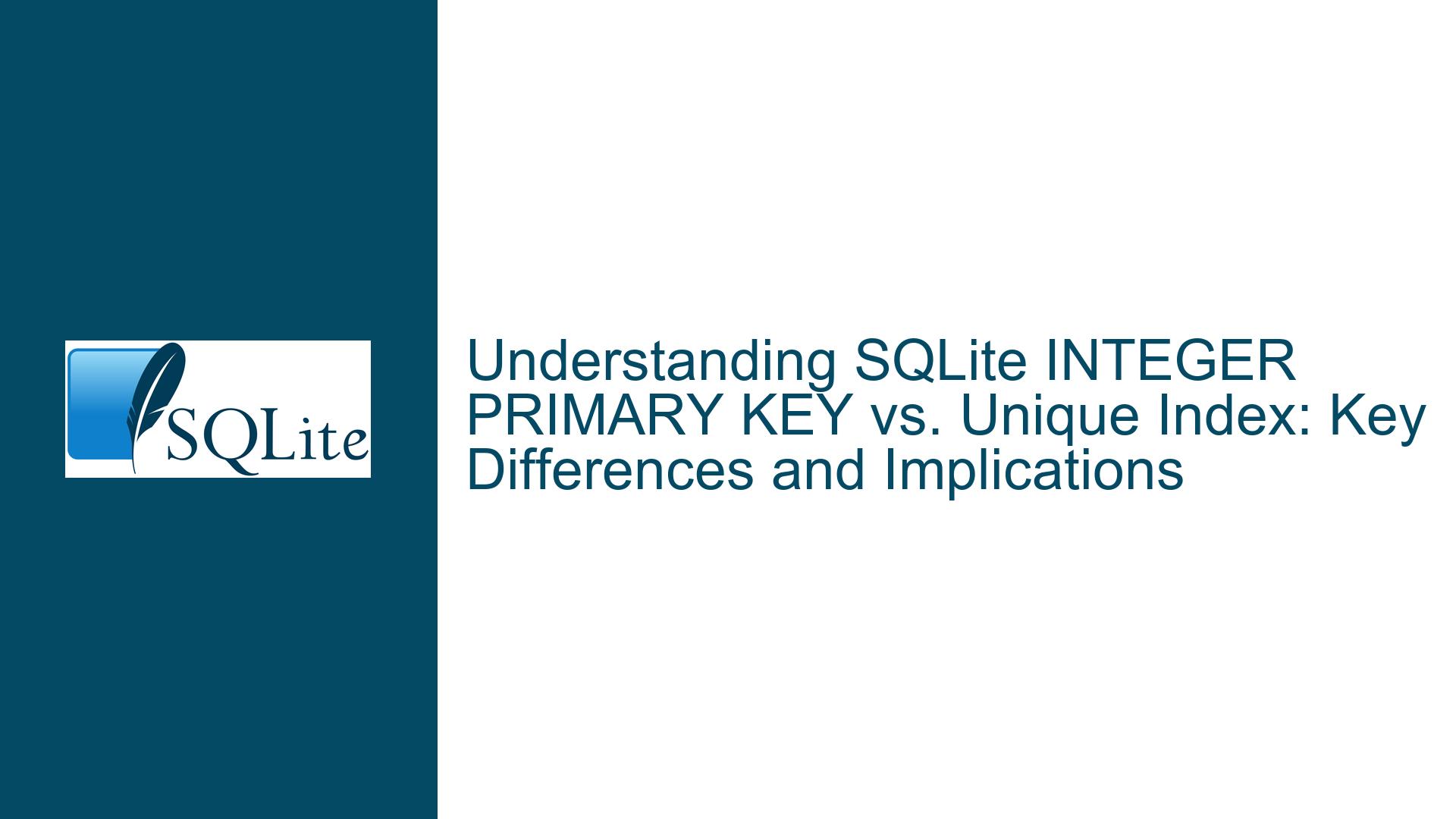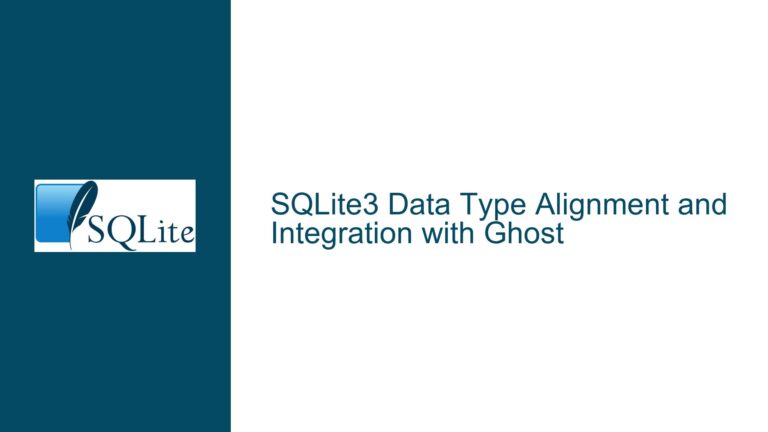SQLite INTEGER PRIMARY KEY vs. Unique Index: Key Differences and Implications
INTEGER PRIMARY KEY as an Alias for ROWID
In SQLite, the INTEGER PRIMARY KEY column is a special construct that serves as an alias for the internal ROWID of a table. Every row in a SQLite table has a unique 64-bit signed integer ROWID that identifies it within the table. When a column is defined as an INTEGER PRIMARY KEY, SQLite uses this column to store the ROWID value directly. This means that the INTEGER PRIMARY KEY column and the ROWID are effectively the same entity, and accessing one is equivalent to accessing the other.
The ROWID is automatically assigned by SQLite unless explicitly provided during an INSERT operation. If a table is created with an INTEGER PRIMARY KEY column, SQLite ensures that this column behaves like the ROWID. For example, if you create a table with CREATE TABLE t(id INTEGER PRIMARY KEY, ...);, the id column will store the ROWID values. This design allows for efficient storage and retrieval, as the ROWID is used internally for indexing and organizing the table’s data.
However, if you create a table without an INTEGER PRIMARY KEY and instead define a unique index on an integer column, such as CREATE TABLE t(id INTEGER, ...); CREATE UNIQUE INDEX id ON t(id);, the id column is not an alias for the ROWID. Instead, it is a separate column with a unique constraint enforced by an index. This distinction is crucial because the ROWID and the id column are now two distinct entities. The ROWID is still present and can be accessed using the default ROWID, OID, or _ROWID_ aliases, but it is not tied to the id column.
The INTEGER PRIMARY KEY column’s behavior is unique to SQLite and is not replicated by simply creating a unique index on an integer column. This difference has significant implications for performance, storage, and referential integrity, which will be explored in the following sections.
Consequences of Using Unique Index Instead of INTEGER PRIMARY KEY
When a unique index is used instead of an INTEGER PRIMARY KEY, several consequences arise that affect the database’s behavior and performance. First, the ROWID and the indexed column are no longer the same entity. This separation means that the ROWID is managed independently by SQLite, while the indexed column is managed by the unique index. This can lead to increased storage requirements, as both the ROWID and the indexed column must be stored separately.
Second, the unique index does not benefit from the same optimizations as the INTEGER PRIMARY KEY. For example, the ROWID is used internally by SQLite for efficient row lookup and storage organization. When a unique index is used, SQLite must maintain an additional index structure, which can slow down insert, update, and delete operations. This is because every modification to the indexed column requires updating the index, whereas the ROWID is inherently indexed by SQLite.
Third, the unique index does not provide the same guarantees as the INTEGER PRIMARY KEY regarding referential integrity. If a table has foreign key constraints referencing the id column, using a unique index instead of an INTEGER PRIMARY KEY can lead to inconsistencies. For example, if the id column is updated, the unique index must be updated accordingly, but the ROWID remains unchanged. This discrepancy can cause issues with foreign key relationships, as the referenced id values may no longer match the actual ROWID values.
Finally, the unique index does not allow for the same level of control over the ROWID as the INTEGER PRIMARY KEY. With an INTEGER PRIMARY KEY, you can explicitly set the ROWID value during an INSERT operation, which can be useful for certain use cases. However, with a unique index, the ROWID is managed entirely by SQLite, and you cannot directly control its value.
Converting a Unique Index to INTEGER PRIMARY KEY After Table Creation
One common question is whether it is possible to convert a unique index to an INTEGER PRIMARY KEY after a table has been created. The short answer is no. SQLite does not provide a direct way to alter a table’s schema to change a unique index into an INTEGER PRIMARY KEY. This limitation stems from the fundamental differences between the two constructs, as discussed earlier.
When a table is created with an INTEGER PRIMARY KEY, SQLite assigns the ROWID to this column, and the column becomes an alias for the ROWID. This relationship is established at the time of table creation and cannot be changed afterward. If you attempt to add an INTEGER PRIMARY KEY to an existing table, SQLite will treat it as a new column, and it will not be linked to the ROWID.
To achieve the desired behavior, you would need to create a new table with the INTEGER PRIMARY KEY column and migrate the data from the old table to the new table. This process involves several steps:
- Create a new table with the
INTEGER PRIMARY KEYcolumn:CREATE TABLE new_table(id INTEGER PRIMARY KEY, ...); - Copy the data from the old table to the new table:
INSERT INTO new_table SELECT * FROM old_table; - Drop the old table:
DROP TABLE old_table; - Rename the new table to the original table name:
ALTER TABLE new_table RENAME TO old_table;
This approach ensures that the id column in the new table is an alias for the ROWID, providing the same benefits as if the table had been created with an INTEGER PRIMARY KEY from the start. However, this process can be time-consuming and may require careful handling of foreign key constraints and indexes.
In summary, while it is not possible to directly convert a unique index to an INTEGER PRIMARY KEY after table creation, you can achieve the same result by creating a new table and migrating the data. This approach ensures that the id column is properly linked to the ROWID, providing the performance and integrity benefits associated with the INTEGER PRIMARY KEY.
Performance Implications of INTEGER PRIMARY KEY vs. Unique Index
The choice between using an INTEGER PRIMARY KEY and a unique index has significant performance implications, particularly for large datasets and high-throughput applications. The INTEGER PRIMARY KEY benefits from SQLite’s internal optimizations, which make it more efficient for certain operations compared to a unique index.
One of the key performance advantages of the INTEGER PRIMARY KEY is that it is inherently indexed by SQLite. This means that lookups, inserts, updates, and deletes involving the ROWID are highly efficient, as SQLite can directly access the row using the ROWID without needing to traverse an additional index structure. In contrast, a unique index requires SQLite to maintain a separate index, which adds overhead to these operations.
Another performance consideration is the order of insertion. When using an INTEGER PRIMARY KEY, inserting rows in primary key order can be more efficient than inserting them in random order. This is because SQLite can optimize the storage layout to minimize B-tree manipulation, reducing the overhead of maintaining the index. However, if rows are inserted in random order, the INTEGER PRIMARY KEY may still incur some overhead due to the need to reorganize the B-tree structure.
In contrast, a unique index does not benefit from these optimizations. Every insert, update, or delete operation involving the indexed column requires updating the index, which can be slower, especially for large datasets. Additionally, the unique index does not provide the same level of control over the storage layout, which can lead to increased fragmentation and reduced performance over time.
To illustrate the performance differences, consider the following table:
| Operation | INTEGER PRIMARY KEY | Unique Index |
|---|---|---|
| Insert (ordered) | Fast | Moderate |
| Insert (random) | Moderate | Slow |
| Lookup | Fast | Moderate |
| Update | Fast | Moderate |
| Delete | Fast | Moderate |
As shown in the table, the INTEGER PRIMARY KEY generally outperforms the unique index for most operations, particularly when rows are inserted in primary key order. However, the performance difference may be less pronounced for small datasets or applications with low throughput.
In conclusion, the INTEGER PRIMARY KEY offers significant performance advantages over a unique index, particularly for large datasets and high-throughput applications. By leveraging SQLite’s internal optimizations, the INTEGER PRIMARY KEY provides faster and more efficient access to the table’s rows, making it the preferred choice for most use cases.
Best Practices for Using INTEGER PRIMARY KEY and Unique Index
When designing a SQLite database, it is important to follow best practices to ensure optimal performance and maintainability. The choice between using an INTEGER PRIMARY KEY and a unique index is a critical decision that can have long-term implications for your database.
Prefer INTEGER PRIMARY KEY for Primary Key Columns: Whenever possible, use an
INTEGER PRIMARY KEYfor primary key columns. This approach leverages SQLite’s internal optimizations and ensures that the primary key column is an alias for theROWID, providing efficient storage and retrieval.Use Unique Indexes for Non-Primary Key Columns: For columns that require uniqueness but are not primary keys, use a unique index. This approach ensures that the column values are unique while avoiding the overhead of maintaining a separate index for the primary key.
Insert Rows in Primary Key Order: When using an
INTEGER PRIMARY KEY, insert rows in primary key order to minimize B-tree manipulation and improve performance. This practice is particularly important for large datasets and high-throughput applications.Avoid Converting Unique Indexes to INTEGER PRIMARY KEY After Table Creation: As discussed earlier, it is not possible to directly convert a unique index to an
INTEGER PRIMARY KEYafter table creation. Instead, create a new table with theINTEGER PRIMARY KEYand migrate the data if necessary.Consider the Impact on Foreign Key Constraints: When designing tables with foreign key constraints, ensure that the referenced columns are
INTEGER PRIMARY KEYcolumns. This approach ensures referential integrity and avoids potential issues with inconsistentROWIDvalues.Monitor and Optimize Index Performance: Regularly monitor the performance of your indexes and optimize them as needed. Use tools like
EXPLAIN QUERY PLANto analyze query performance and identify potential bottlenecks.
By following these best practices, you can ensure that your SQLite database is designed for optimal performance, maintainability, and scalability. The choice between using an INTEGER PRIMARY KEY and a unique index is a critical decision that should be made with careful consideration of the specific requirements and constraints of your application.
Conclusion
The distinction between an INTEGER PRIMARY KEY and a unique index in SQLite is a fundamental concept that has significant implications for database design, performance, and integrity. The INTEGER PRIMARY KEY serves as an alias for the internal ROWID, providing efficient storage and retrieval, while a unique index enforces uniqueness but does not benefit from the same optimizations.
Understanding the differences between these two constructs is essential for designing efficient and maintainable SQLite databases. By following best practices and carefully considering the specific requirements of your application, you can make informed decisions that ensure optimal performance and integrity.
In summary, prefer using an INTEGER PRIMARY KEY for primary key columns, use unique indexes for non-primary key columns, and avoid converting unique indexes to INTEGER PRIMARY KEY after table creation. By adhering to these guidelines, you can leverage the full power of SQLite and build robust, high-performance databases.






